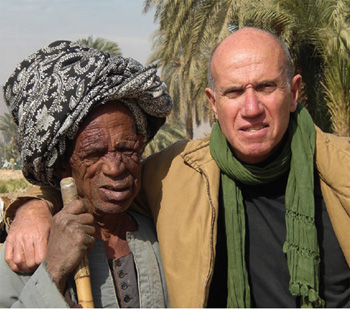Black Genesis (21 page)


More on Hawass
More recently, the
New York times
was even more candid about Dr. Hawass's behavior to colleagues, students, and other researchers.
Zahi Hawass, secretary general of the Supreme Council of Antiquities in Egypt, seems to get his name in the papers and his face on television every time anyone sticks a shovel in the ground there. The resulting fameâthe man has become ubiquitous on history-heavy American cable channelsâhas apparently given Dr. Hawass, like many celebrities before him, the mistaken impression that any sort of personal behavior will be embraced by his adoring public, because he sure is obnoxious on “Chasing Mummies,” an annoying new show that begins Wednesday night on History. Dr. Hawass has allowed a History crew to tag along as he does what he does, but, at least from the evidence of the premiere, this does not result in many revelations about the science of archaeology. It results instead in a fair amount of footage of Dr. Hawass verbally abusing those around him: the film crew, college-age interns who have come to worship at his feet, and so on. Any infraction, or no infraction at all, seems sufficient to warrant one of Dr. Hawass's
tirades.
37

We have experienced Hawass's anger since early 1994, when our first book,
The Orion Mystery,
was published. He branded Robert Bauval and his colleagues as liars, amateurs, pyramidologists, pyramidiots, and, befuddling as it may seem, even Zionists who were trying to steal the pyramids. In fact, when it comes to the ethnic origins of the ancient Egyptians or who built the pyramids, Hawass has issued some rather odd statements. For example, when, in 2002, a small robot was used to explore narrow shafts in the Great Pyramid of Giza, he told a bemused journalist of the popular
Al-Gomhoreya
newspaper: “The results of the robot's exploration refute the allegations reiterated by Jews and some Western countries that the Jews built the
pyramids!”
38
Hawass's superior, Egypt's Minister of Culture Farouk Hosni, made a very similar bizarre statement: “Israeli allegations that they built the Pyramids abound, and we must face up to this even if it triggers a crisis with Israel! This is piracy! Our history and our civilization must be respected but the Israelis want to take over everything! We must counterattack with full strength because this is how they took Palestine. They keep on saying Palestine belongs to them and now they are doing the same with the
Pyramids!”
39
Further, Hawass added to this: “A group of people are making an organized campaign. There are some people pushing them [Israel]. . . . These people are waging a big attack against us. I swore two years ago that I would not reveal their names, but I found out that I must mention them because it is becoming a threat . . . there is among us a bad person, a Jew . . . and I will tell the public that everyone who tries to talk against the Egyptians should shut their
mouths!”
40
According to Hawass, a member of the group allegedly waging a “big attack” backed by Israel against the Egyptians is Robert Bauval. Bauval is a Christian, not a Jew, and, ironically, he was born and raised in Egypt.
*40
In a more recent television interview in February 2009, Hawass unabashedly claimed that the Jews “control the entire world” and that “. . . for eighteen centuries they [the Jews] were dispersed throughout the world . . . they went to America and took control of its economy . . . they have a plan: Although they are few in number, they control the entire world . . . look at the control they have over America and the
media!”
42
Needless to say, with this type of display by the chief of the SCA, any claim, however scientific and scholarly, of a Black African origin for Egypt's ancient civilization will inevitably be met with indifference and, more likely, with opposition. Indeed, Hawass has already made this quite clear with his latest commentaries on this issue to the official Egyptian MENA News Agency: “. . . the portrayal of ancient Egyptian civilization as black has no element of truth to it! Egyptians are not Arabs and are not Africans despite the fact that Egypt is in
Africa . . . !”
43
According to this kind of logic, though Egypt is in Africa, Egyptians are not Africans. Such blatant contradiction most likely stems from the fact that Hawass probably equates Africans and Blacks. Therefore, any connection between the ancient Egyptians and Blacks or Africans must be rejected at all cost, even if it contradicts geographical realities. Perhaps this extreme view clarifies other, less blatant but still puzzling attacks that scholars have made in their academic publishing. Facts, however, are facts: Egypt is in Africa, Egyptians are Africans, and there is now overwhelming evidence that ancient Egyptians have a Black African origin.
Rejection of an Article

In early 2008, Thomas Brophy, together with another coauthor, submitted to an academic journal a paper about a small part of the proposed astronomy of Nabta Playa. The journal returned it with a critical review from an anonymous referee (perhaps from an Egyptian scholar) who, in the course of recommending that the journal reject the paper, actually referred to Brophy and his colleagues as “behaving like arrogant Westerners.” We were puzzled by that strange comment. Why, we thought, would an accomplished scholar make such a personal attack within the formal review process? It seemed out of context. Then it dawned on us: perhaps he was speaking from a perspective formed partly by a racially hierarchical worldview. If this was true, it would be natural for him to have a sort of chip on his shoulder about Westerners. In Brophy's paper, as far as we were thinking at the time, we were simply proposing a solution to an astronomy puzzle. He and his colleagues made no mention of or concerned themselves with any contemporary racial-cultural implications of their paper. Yet we now understand why those innocent suggestions about astronomy at Nabta Playa may have been perceived as a threat.

At this point, we must state categorically that we are not trying to steal the pyramids, we are not claiming to have built the pyramids, and we are not claiming that our friends and familyâor even our ethnic groupâbuilt them. We say this with tongue in cheek, of courseâhoping that the SCA director will make room for some humor and a broader perspective. We must also acknowledge that Dr. Hawass, as a deputy minister of the Egyptian government, could well be under pressure from various contemporary sociopolitical sources. It is reasonable, then, to suppose that not all of his commentaries are motivated purely by dispassionate analysis of events from four or five thousand years ago but may be colored in small part by contemporary sociopolitical concerns. Yet the modern Egyptian government has been a leader in the terribly difficult, indeed Herculean, contemporary efforts to transcend the ages-old rivalry between Egypt and Israel as evidenced for example by the 1979 peace treaty for which Egyptian president Anwar Sadat shared the Nobel Peace Prize. If in some sense, therefore, there is a subliminal struggle going on among the various currently powerful ethnonationalist and subnationalist groups in Egypt today regarding claims of the origin of the civilization that built the pyramids, then it seems that the emerging answer should serve not to inflame but to defuse the situationâbecause the answer is that the origins stem not from any of these groups but from Black Africans. Certainly it was the Black Africans of Egypt who, over the subsequent ages, melded with a number of other colors and ethnicities and thus essentially are today the same people of Egypt who should be extremely proud of the ancient accomplishments of their heritage.
CONSOLIDATING THE EVIDENCE
Other than the visual evidence of prehistoric rock art at Uwainat and Gilf Kebir, we will also see here and in chapter 6 that there is even more supporting evidence of a Black African origin in further analysis of the astronomical alignments at Nabta Playa and other prehistoric sites in the Egyptian Sahara. Meanwhile, in 2002, three decades after Nabta Playa was discovered, anthropologists Fred Wendorf and Romuald Schild published their overall views in the
Journal of the Polish Academy of Science
[
Archaeologia Polona
] affirming that
[t]he tumuli, calendar, stele alignments and megalithic constructions, all concentrated around western shores of the then already dried ancient Lake Nabta, indicate that this area was an important ceremonial centre in the late and final Neolithic. The complexity of the arrangements, and enormous amount of closely managed work put into the construction of the megalithic constructions, indicate that the cattle herders of the South Western Desert created an early complex society with the presence of a religious and/or political control over human resources for an extended period of time. Common contacts of the Desert Dwellers with the Nile Valley inhabitants are indicated by frequent presence of raw material and ceramics originating in the Nile Valley. These contacts of cattle pastoralists with Predynastic, agricultural groups in the Nile Valley may have played an important role in the emergence of a complex, stratified society in the Great River Valley. . . . Physical anthropology of rare skeletal remains found in the late early, middle and late Neolithic suggests racial association of the populations with Sub-Saharan or black
groups . . .
44
Other eminent anthropologists were more categorical. In
National Geographic News
of July 2006, this article appeared:
The pharaohs of ancient Egypt owed their existence to prehistoric climate changes in the eastern Sahara, according to an exhaustive study of archaeological data that bolsters this theory.
Starting at about 8500 B.C., researchers say, broad swaths of what are now Egypt, Chad, Libya and Sudan experience a “sudden onset of humid conditions.” . . . During this time the prehistoric people of the eastern Sahara followed the rains to keep pace with the most hospitable ecosystems.
But around 5300 B.C. this climate-driven environmental abundance started to decline, and most humans began leaving the increasingly arid region.
“Around 5,500 to 6,000 years ago the Egyptian Sahara became so dry that nobody could survive there.” Said Stefan Kröpelin, a geoarchaeologist at the University of Cologne in Germany and study co-author. . . .
Among their findings, the researchers provide further evidence that the human exodus from the desert about 5,000 years ago is what laid the foundation for the first pharaoh's rule . . .
David Phillipson, a professor of African archaeology, directs the Museum of Archaeology and Anthropology at the University of Cambridge in England . . .
“As the Sahara dried and became less suited and eventually unsuited to habitation, people ultimately had to move out, whether it be southward or to the east into the Nile Valley,” Phillipson said.
“And this [study] helps [us] to understand the apparent rather sudden development of intensive settlement by sophisticated societies in the Nile Valley 'round about five or six thousand
years ago.”
45
Michal Kobusiewicz and Romuald Schild are both renowned anthropologists who have studied Nabta Playa under the aegis of the Institute of Archaeology and Ethnology of the Polish Academy of Sciences. After pointing out that the ancient Egyptian pharaonic state was formed around 3300 BCE, they commented that “we already know that soon after this date, drought forced the [Nabta Playa] herdsmen to abandon their lands . . . and so where might they have gone, if not to the relatively close Nile Valley? They brought with them the various achievements of their culture and their belief system. Perhaps it was indeed these people who provided the crucial stimulus towards the emergence of state organization in ancient
Egypt.”
46
Schild and Kubusiewicz also call “these people” prehistoric herdsmen, prehistoric pastoralists, Neolithic cattle herders, and sub-Saharans. The term
Black,
however, is clearly avoided. As we have seen, the ancient sub-Saharan people were of the pre-Tebu Black race whose ancestors inhabited the Tibesti and Ennedi Mountains of northern Chadâbut who really were the Tebu? How did they look? In the 1860s, the German explorer Gerhard Rohlfs was among the first Europeans who had made contact with the elusive Tebu people.
Their stature is svelte, their members fine, their disposition light and swift; they have lively eyes, their lips are a bit tough, their nose is small but not snubbed, and their hair is short but less wiry than the Negroes. . . . All other travelers who made contact with the Tebu have noted that their physical traits tend more towards the Negro . . . their customs and traditions are also nearer to that of the Negro . . . the land of the present day Tebu is located south of Fazan, in the north of
Lake Chad . . .
47
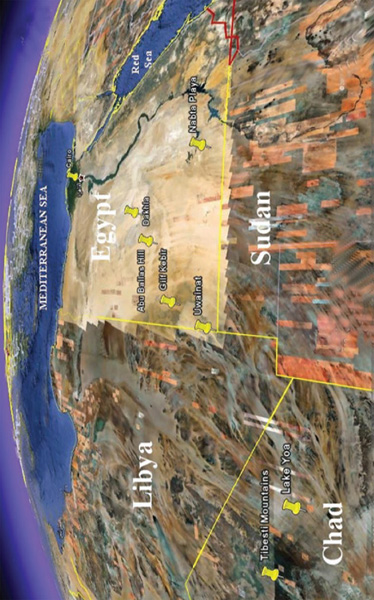
Plate 1. Satellite map of the Egyptian Sahara (produced in part using Google Earth)
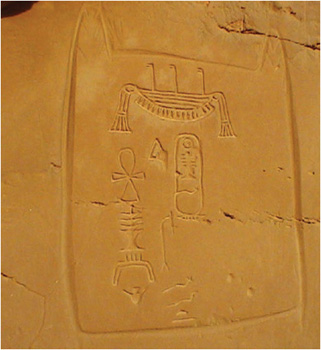
Plate 2. Djedefre Water Mountain, central cartouche, east face

Plate 3. Mahmoud Marai (left) and Mark Borda with the newly discovered Uwainat Inscriptions, November 2007
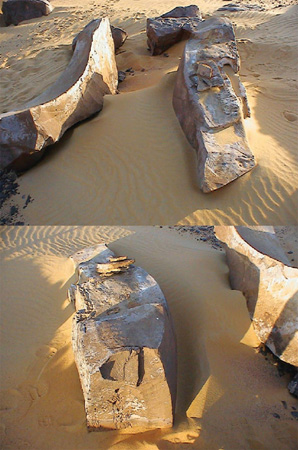
Plate 4. Two views of the megaliths that were arranged on top of CSA before CSA was excavated. These appear to be shaped as if fitted together or symbolic of connection. Images taken October 2003. As of April 2008, one of these megaliths was removed, possibly to the Nubian Museum.
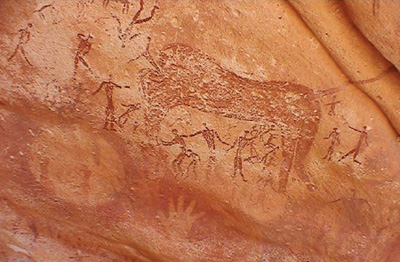
Plate 5. A human figure emerging from the head of a large animal, possibly a lion, in the midst of a group dance. This appeared to us to be reminiscent of modern shamanic imagery (in which a shaman enters the mind of a powerful animal as part of a ritual). Lower left, a large orb, possibly the sun or moon, with a single hand. Mester Kawai-Foggini cave, southwest Gilf Kebir.
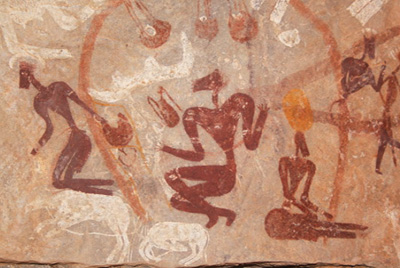
Plate 6. Domestic scene with cattle at the Uwainat cave
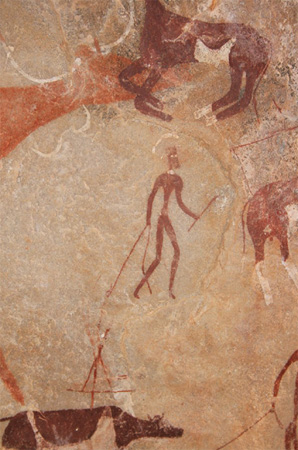
Plate 7. Human with cattle on a leash, Uwainat cave
